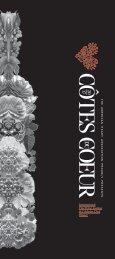You also want an ePaper? Increase the reach of your titles
YUMPU automatically turns print PDFs into web optimized ePapers that Google loves.
Domaine Paul BLANCK<br />
In 1610, Hans Blanck, the family’s Austrian ancestor, acquired the first<br />
vines in Alsace. Jacques Philippe Blanck obtained a medal for this<br />
work as a winemaker in 1846, and in 1927, found Paul Blanck and a<br />
handful of other winemakers being recognized as the driving force<br />
behind turning the site of Schlossberg into a pilot site for a future<br />
grand cru.<br />
In 1975, <strong>with</strong> the creation of the grand cru appellation in Alsace,<br />
Bernard and Marcel Blanck, the sons, played a determining role.<br />
Schlossberg was the first to be assigned this appellation. A new<br />
generation of winemakers—Frédéric and Philippe—entered the<br />
scene in 1985. Their main preoccupation is respecting the vines and<br />
the soil upon which they are planted.<br />
The domain has increased its surface area from 24 to 36 hectares <strong>with</strong><br />
five grand crus accounting for more than a third.<br />
The Blanck Family<br />
This is a reality for the Blancks. The proof is that two generations of<br />
Blancks work hand in hand. The sons, Frédéric and Philippe, work<br />
incessantly under the supervision of Bernard and Marcel to improve<br />
their wines and move in new directions.<br />
The Blancks are environmentally conscious. The 36 hectares of the<br />
Domaine are farmed <strong>with</strong> traditional copper and sulphur treatment<br />
and no fertilizer. All the vineyards are plowed several times in the<br />
year. Indigene grass is grown to develop the biodiversity of the fauna.<br />
The Blanck’s main objective is to create wines of pure pleasure for<br />
food and wine lovers throughout the world.<br />
The thirty different wines from the property can be separated into<br />
three main types: fruit-driven wines which enable the wine-lover to<br />
discover the aromatic finesse of the Alsace grape varieties; “terroir”<br />
wines <strong>with</strong> stony characteristics from the single vineyard’s wines and<br />
grand crus which express the plenitude of limestone, the sweetness<br />
and firmness of clay, the harmony of manganese an the racy bouquet<br />
and power coming from silica, and nectars wines—late-harvested<br />
and “grains nobles” wines, issued from over - ripe grapes, which are<br />
mysterious, opulent, complex and exuberant.<br />
www.blanck.com<br />
62



